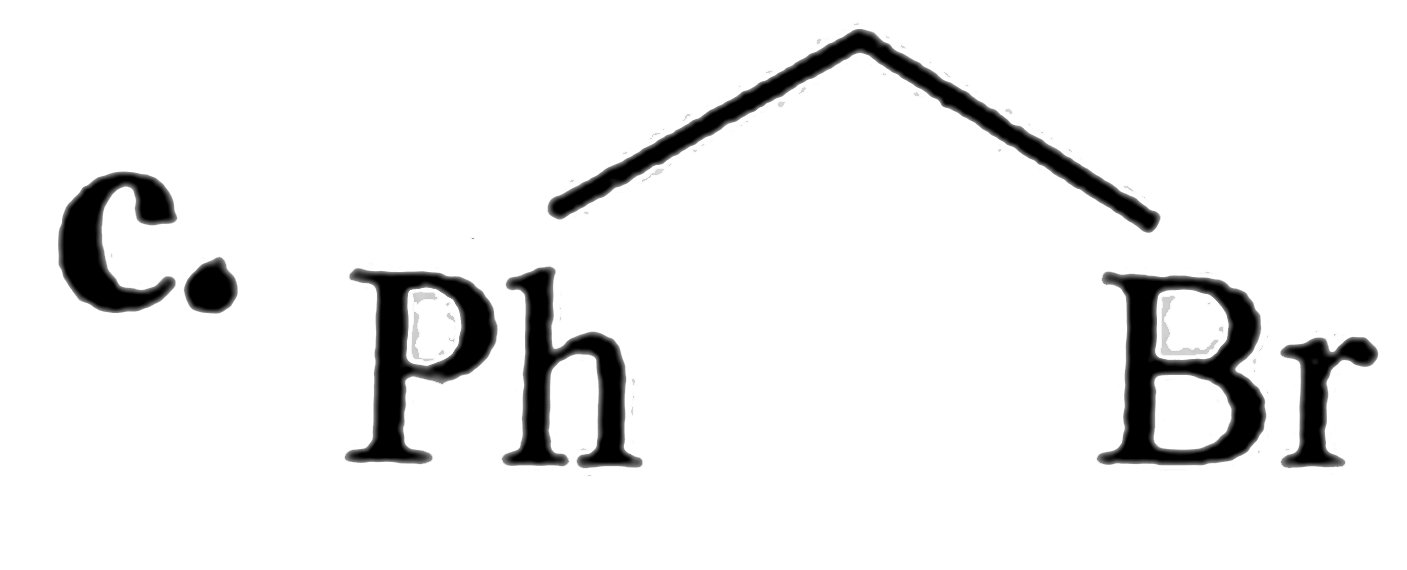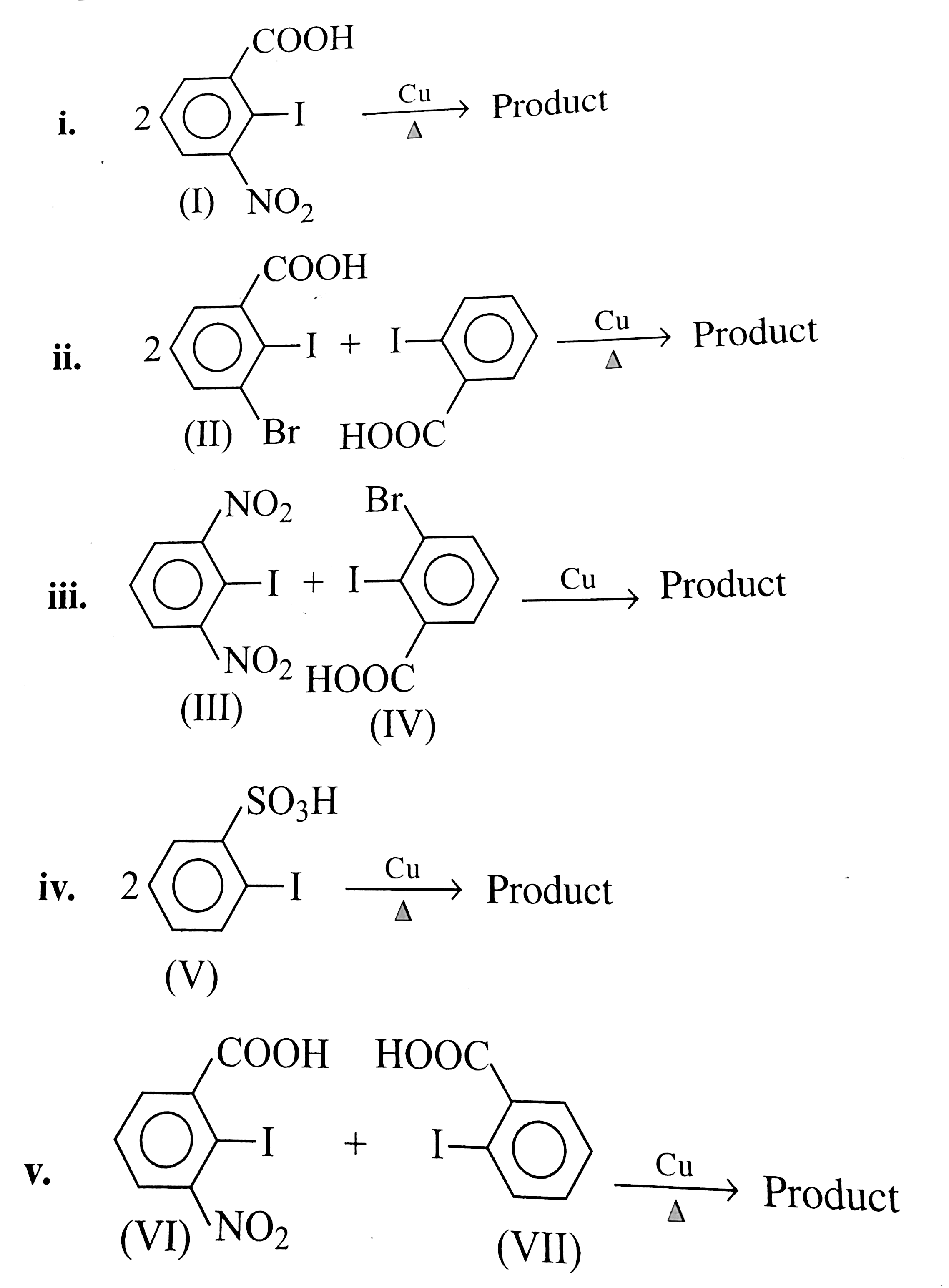SN2 reaction is a bimolecular reaction which takes places by the formation of T.S. Veolcity of the reaction depends on the concentration of the substrate as well as the nucleophile.
The reaction is favoureed by strong Nuo− and in the presence of polar aprotic sovlent, optically active halides give. Walken inversion by SN2 mechanism. The presence of hero group (atom) at β−C atom, unsaturation at β−C and ⎛⎜
⎜⎝−O∣∣C−⎞⎟
⎟⎠ group at α−C atomn favor SN2 mechanism.
Allyl halides and benzyl halides give SN1 and SN2 reactions. Allyl halides alos give SN2 mechanism EDG at ortho- and para- postions in benzyl halides favors SN1 mechanism, wheras EWG favors SN2 mechanism.
Which of the following will give SN2 mechanism?
MeBr


All
The correct Answer is:d
All, (a)⇒1∘RX,(b)⇒ Allyl halide, (c)⇒ Benzyl halide.
Topper's Solved these Questions
- AROMATIC COMPOUNDS AND ALKYL AND ARYL HALIDES BOOK - CENGAGE CHEMISTRYCHAPTER - AROMATIC COMPOUNDS AND ALKYL AND ARYL HALIDES EXERCISE - Exercises Multiple Correct
35 Videos
- AROMATIC COMPOUNDS AND ALKYL AND ARYL HALIDES BOOK - CENGAGE CHEMISTRYCHAPTER - AROMATIC COMPOUNDS AND ALKYL AND ARYL HALIDES EXERCISE - Exercises Multiple Correct Answers Type
12 Videos
- AROMATIC COMPOUNDS AND ALKYL AND ARYL HALIDES BOOK - CENGAGE CHEMISTRYCHAPTER - AROMATIC COMPOUNDS AND ALKYL AND ARYL HALIDES EXERCISE - Exercises Linked Compreshension Type
11 Videos
- APPENDIX INORGANIC VOLUME 2BOOK - CENGAGE CHEMISTRYCHAPTER - APPENDIX INORGANIC VOLUME 2EXERCISE - Short Answer Type
179 Videos
- BIOMOLECULESBOOK - CENGAGE CHEMISTRYCHAPTER - BIOMOLECULESEXERCISE - Exercises Archives (Analytical And Descriptive)
8 Videos
Similar Questions
Both t−butyl and (−SO3H) groups are used as a blocking group in certain synthesis of organic compounds. Which of the following statements are correct?
View Solutionβ− Elimination or anti-eliminination reaction is carried out with base (Bo−) as shown below:

The following bases are used.
I. o−OH , II. ROo−
II. ROo−
III. RCOOo− , IV. o−CN
V. NOo−3
The decreasing order of reactivity for the above elimination is:
View Solution
The type of stereosim arising from restricted rotation about a single bond and where the stereoisomers can be isolated is called.
View SolutionWhich metals are generally extracted by the electrolytic processes ? What positions these metals generally occupy in the periodic table?
View SolutionWrite the structure of alanine at pH=2andpH=10.
View SolutionWalden inversion takes place in SN2 reaction.
Half-life period of SN2 reaction is inversely proportional to the concentration of the substrate or nucleophile or both.
View SolutionVelocity of the S_(N^(2)) reaction depends on the concentration of the substrate as well as te nucleophile. The reaction is favoured by strong Nu^(overset(..)(ө)) , and in the presence of polar aprotic solvent, optically active halides give walden inversion by S_(N^(2)) mechanism. the presence of hetro group (atom as beta-C atom, unsaturation at beta-C , and (-overset(O)overset(||)(C)-) Allyl halides also give S_(N^(2)) mechanism. EDG at ortho-and para-positions in benzyl halides favours S_(N^(1)) mechanism, whereas EWG favours S_(N^(2)) mechanism. Q. Which of the following will give S_(N^(2)) mechanism
View SolutionVelocity of the S_(N^(2)) reaction depends on the concentration of the substrate as well as te nucleophile. The reaction is favoured by strong Nu^(overset(..)(ө)) , and in the presence of polar aprotic solvent, optically active halides give walden inversion by S_(N^(2)) mechanism. the presence of hetro group (atom as beta-C atom, unsaturation at beta-C , and (-overset(O)overset(||)(C)-) Allyl halides also give S_(N^(2)) mechanism. EDG at ortho-and para-positions in benzyl halides favours S_(N^(1)) mechanism, whereas EWG favours S_(N^(2)) mechanism. Q. Which of the following will give Walden inversion
View SolutionSN^(2) reaction is a bimolecular reaction which takes places by the formation of T.S. Veolcity of the reaction depends on the concentration of the substrate as well as the nucleophile. The reaction is favoureed by strong Nu^(o-) and in the presence of polar aprotic sovlent, optically active halides give. Walken inversion by SN^(2) mechanism. The presence of hero group (atom) at beta-C atom, unsaturation at beta-C and (-overset(O)overset(||)(C)-) group at alpha-C atomn favor SN^(2) mechanism. Allyl halides and benzyl halides give SN^(1) and SN^(2) reactions. Allyl halides alos give SN^(2) mechanism EDG at ortho- and para- postions in benzyl halides favors SN^(1) mechanism, wheras EWG favors SN^(2) mechanism. Which of the following will give Walden inversion ?
View SolutionSN^(2) reaction is a bimolecular reaction which takes places by the formation of T.S. Veolcity of the reaction depends on the concentration of the substrate as well as the nucleophile. The reaction is favoureed by strong Nu^(o-) and in the presence of polar aprotic sovlent, optically active halides give. Walken inversion by SN^(2) mechanism. The presence of hero group (atom) at beta-C atom, unsaturation at beta-C and (-overset(O)overset(||)(C)-) group at alpha-C atomn favor SN^(2) mechanism. Allyl halides and benzyl halides give SN^(1) and SN^(2) reactions. Allyl halides alos give SN^(2) mechanism EDG at ortho- and para- postions in benzyl halides favors SN^(1) mechanism, wheras EWG favors SN^(2) mechanism. Which of the following will gives SN^(2) mechanism gt
View SolutionSN^(2) reaction is a bimolecular reaction which takes places by the formation of T.S. Veolcity of the reaction depends on the concentration of the substrate as well as the nucleophile. The reaction is favoureed by strong Nu^(o-) and in the presence of polar aprotic sovlent, optically active halides give. Walken inversion by SN^(2) mechanism. The presence of hero group (atom) at beta-C atom, unsaturation at beta-C and (-overset(O)overset(||)(C)-) group at alpha-C atomn favor SN^(2) mechanism. Allyl halides and benzyl halides give SN^(1) and SN^(2) reactions. Allyl halides alos give SN^(2) mechanism EDG at ortho- and para- postions in benzyl halides favors SN^(1) mechanism, wheras EWG favors SN^(2) mechanism. Which of the following will give SN^(1) reaction?
View SolutionAliphatic nucleophilic substitution mainly takes place by two mechanisms (i.e) SN^1 & SN^2 Primary halides mainly undergo by SN^2 mechanism and are favourable in polar aprotic solvents. SN^1 reactions takes place mainly by tertiary halide and are more favourable in polar protic solvents, In case of tertiary halides, E_1 comes competition to SN^1 reaction. Keeping in view of these general points, answer the following questions Which of the following reactions, the reactions takes place by SN^1 mechanism mainly.
View SolutionSN^2 reactions of alkyl halides is a bimolecular reaction which take place through formation of a transition state. The rate of reaction depends on the concentration of alkyl halide and nucleophile.The reaction is favoured by strong nucleophlie in polar aprotic solvents. Which of the following undero substitution by SN^2 mechanism at a faster rate from other
View SolutionSN2 reactions of alkyl halides is a bimolecular reaction which take place through formation of a transition state. The rate of reaction depends on the concentration of alkyl halide and nucleophile.The reaction is favoured by strong nucleophlie in polar aprotic solvents.
In which of the following solvents SN2 reaction is more favourable
View SolutionSN^2 reactions of alkyl halides is a bimolecular reaction which take place through formation of a transition state. The rate of reaction depends on the concentration of alkyl halide and nucleophile.The reaction is favoured by strong nucleophlie in polar aprotic solvents. In the transition state in the SN^2 reaction is represented as . The central carbon atom is
View Solution
